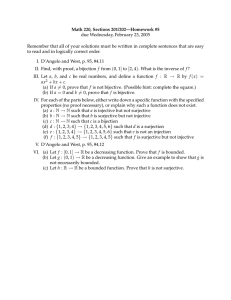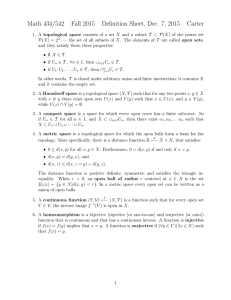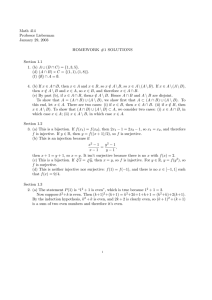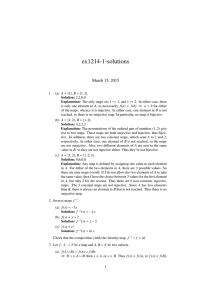MATH 2200 Final LC Review 1 Final LC Format Thomas Goller
advertisement
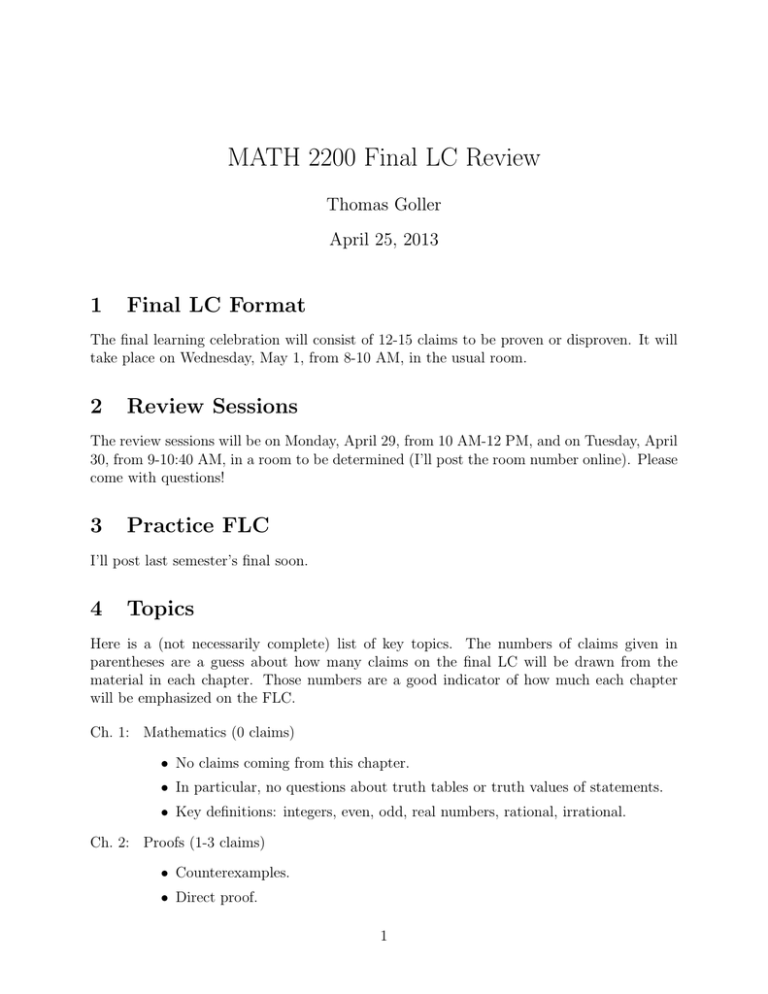
MATH 2200 Final LC Review
Thomas Goller
April 25, 2013
1
Final LC Format
The final learning celebration will consist of 12-15 claims to be proven or disproven. It will
take place on Wednesday, May 1, from 8-10 AM, in the usual room.
2
Review Sessions
The review sessions will be on Monday, April 29, from 10 AM-12 PM, and on Tuesday, April
30, from 9-10:40 AM, in a room to be determined (I’ll post the room number online). Please
come with questions!
3
Practice FLC
I’ll post last semester’s final soon.
4
Topics
Here is a (not necessarily complete) list of key topics. The numbers of claims given in
parentheses are a guess about how many claims on the final LC will be drawn from the
material in each chapter. Those numbers are a good indicator of how much each chapter
will be emphasized on the FLC.
Ch. 1: Mathematics (0 claims)
• No claims coming from this chapter.
• In particular, no questions about truth tables or truth values of statements.
• Key definitions: integers, even, odd, real numbers, rational, irrational.
Ch. 2: Proofs (1-3 claims)
• Counterexamples.
• Direct proof.
1
• Proof by contraposition.
• Proof by contradiction.
• Proving logical equivalence (“if and only if” or “the following are equivalent”).
Ch. 3: Sets and functions (3-5 claims)
• Key definitions: set, subset, union, intersection, product, sequence, function,
injective, surjective, bijective, composition of functions, invertible.
• Key theorems: a function is invertible if and only if it is bijective.
• Key set skills: using Venn diagrams for intuition; proving one set is contained
in another and doing this twice to prove two sets are equal.
• Key function skills: appropriately using the definitions of injectivity and surjectivity in proofs, judging whether a function is injective or surjective by looking
at its graph.
• No questions from this chapter about set cardinality.
Ch. 4: Number theory (2-4 claims)
• Key definitions: divides, factor, divisor, multiple, prime factorization, greatest
common divisor, least common multiple, remainder, congruent, modulus.
• Key skills: proving one integer divides another, using the more useful form of
congruence given in Prop. 4.3.6, computing powers of an integer modulo m,
proving divisibility rules.
• Key theorems: infinitely many primes, division algorithm, FTA, Bézout’s identity, Fermat’s little theorem.
• No Euclidean algorithm, no back substitution, no solving linear congruences,
no cryptography.
Ch. 5: Induction (1-3 claims)
• Key terms: induction, base case, inductive step.
• Key skill: using induction to prove summation formulas or number theory
claims.
• No strong induction required.
Ch. 6: Combinatorics (0 claims)
• No claims coming only from this chapter.
• Key definitions: r-permutation, r-combination, factorial.
• Key theorem: product rule, binomial theorem.
• No Pascal’s triangle.
Ch. 7: Graph theory (3-5 claims)
2
• Key definitions: graph, drawing, subgraph, union of subgraphs, intersection of
subgraphs, loop, multiple edges, simple, complete, cycle, bipartite, complete
bipartite, walk, connected, connected component, planar.
• Key theorems: Euler’s formula, inequalities deduced from Euler’s formula.
• No isomorphism, no induction on the size of a graph required.
5
Tips for Proving or Disproving a Claim
(1) Think about whether the claim is plausible. Check cases. Try to construct a counterexample. If you find a counterexample, write “This claim is false!” and give your
counterexample. If the claim seems true, proceed to the next step.
(2) Write the assumptions at the top of your page and the conclusion you want to deduce
at the bottom.
(3) Try to use the assumptions to deduce the conclusion. This may involve:
• Direct proof. Apply definitions to the assumptions and maybe invoke some theorems to directly deduce the conclusion. If this doesn’t work, consider:
• Proof by contrapositive. If the claim is of the form “if p, then q”, try to prove “if
¬q, then ¬p” instead.
• Proof by contradiction. Add the negation of the conclusion to your assumptions
and try to derive a contradiction.
• Proof by induction. If some integer associated to the theorem ranges over all Z≥0
(or Z≥1 , or Z≥2 , etc.), and if the theorem is easier to prove when that integer is
small, then trying induction on that value.
(4) If you found an argument that yields the conclusion, write it out in precise crisp English
sentences! Label it “Proof” and draw your favorite symbol at the end.
(5) If nothing is working, think hard about whether the claim is false! Try to construct a
counterexample based on where you are getting stuck in your attempted proofs.
6
Example Problems
Here is the long list of all relevant claims and exercises from the notes, as well as all claims
from LCs and a few additional claims as well. Many of the claims are false, of course! I am
certainly not recommending that you try to do prove or disprove all of these claims – there
are too many! But do read through the complete list to pinpoint the kinds of claims you’re
least comfortable with, and practice those!
For each claim below, I’ve included its source in parentheses. “E” means “exercise” from
the notes, and a numerical reference without an “E” means the claim was a claim/proposition/theorem
proved in the notes. “LC” of course refers to a learning celebration. I’ve made the source
bold when you have the solution available to you: either because the solution is given in the
3
notes, or because the solution is in one of my “solutions to Homework #n” or “solutions to
LC #n” series of write-ups, which can all be downloaded on my website.
I apologize for all the typos that inevitably populate such a long list of claims.
Chapter 2: Proofs
Claim (2.2.1, 2.3.1). Let n ∈ Z. Then n is odd if and only if n2 is odd.
Claim (E2.2.2a, E2.3.2a). Let n ∈ Z. Then n is even if and only if n2 is even.
Claim (E2.2.2b, 2.3.2b). Let n ∈ Z. Then n is odd if and only if n3 is odd.
Claim (E2.4.2a). Let r be irrational. Then r +
1
2
is irrational.
Claim (E2.4.2b). Let r be irrational. Then 2r is irrational.
Claim (E2.5.2a). Let n ∈ Z. Then n is odd if and only if n + 2 is odd.
Claim (E2.5.2b). Let n ∈ Z. Then n is odd if and only if n + 1 is even.
Claim (2.5.3). Let n ∈ Z. Then the following are equivalent:
(i) n is even;
(ii) n + 1 is odd;
(iii) n + 2 is even.
Claim (E2.5.4). Let n ∈ Z. Then the following are equivalent:
(i) n is odd;
(ii) n − 3 is even;
(iii) n − 2 is odd.
Claim (E2.6.1a). Let m, n ∈ Z. If m is even and n is even, then m + n is even.
Claim (E2.6.1b). Let m, n ∈ Z. If m is even and n is odd, then mn is odd.
Claim (E2.6.1d). Let n ∈ Z. Then n is even if and only if 7n + 4 is even.
Claim (E2.6.1e). Let m, n ∈ Z. If mn is even, then m is even or n is even.
Claim (E2.6.1f). Let n ∈ Z. If n is odd, then n can be written as the sum of the squares of
two integers.
Claim (E2.6.1g). Let n ∈ Z≥0 . Then n can be written as the sum of the squares of three
integers.
Claim (E2.6.2a). Let r, s ∈ R. If r and s are rational, then r + s and rs are rational.
Claim (E2.6.2b). Let r, s ∈ R. If r is rational and s is irrational, then r + s is irrational.
4
Claim (E2.6.2c). Let r, s ∈ R. If r and s are irrational, then rs is irrational.
Claim (E2.6.2d). Let r ∈ R. Then r is rational if and only if r2 is rational.
√
Claim (“Notes on 2.6”). 2 is irrational.
√
(Solutions to E2.6.2b-d and the claim that 2 is irrational can be found in the document
“Notes on 2.6”.)
Claim 1 (LC1). Let m, n ∈ Z. If mn is even, then m is even and n is even.
Claim 2 (LC1). Let m, n ∈ Z. If m is odd and n is odd, then m + n is even.
Claim 3 (LC1). Let n ∈ Z. Then n is odd if and only if 4n − 1 is odd.
Claim 4 (LC1). Let r be irrational. Then
r
3
is irrational.
Claim 5 (LC1). Let r, s ∈ R. If r is rational and s is rational, then rs is rational.
Claim 6 (LC1). Let m, n ∈ Z. If m is odd, then mn is odd.
Chapter 3: Sets and Functions
Claim (3.1.14). Let A, B, and C be sets. Then A ∩ (B ∪ C) = (A ∩ B) ∪ (A ∩ C).
Claim (E3.1.15a). Let A and B be sets. Then A ⊆ B if and only if A ∩ B = A.
Claim (E3.1.15b). Let A, B, and C be sets. Then A ∪ (B ∩ C) = (A ∪ B) ∩ (A ∪ C).
Claim (E3.1.15c). Let A, B, and C be sets. Then C − (A ∪ B) = (C − A) ∩ (C − B).
Claim (E3.1.15d). Let A, B, and C be sets. Then C − (A ∩ B) = (C − A) ∪ (C − B).
Claim (E3.1.15e). Let A, B, and C be sets. If A ∪ C = B ∪ C, then A = B.
Claim (E3.1.15f ). Let A, B, and C be sets. If A ∩ C = B ∩ C, then A = B.
Claim (E3.1.15g). Let A, B, and C be sets. If A ∪ C = B ∪ C and A ∩ C = B ∩ C, then
A = B.
(E3.1.15 is solved in “solutions to Homework #3”.)
Claim (LC2). Let A and B be sets. Then A = (A − B) ∪ (A ∩ B).
Claim (LC2). Let A, B, and C be sets. Then (A − C) ∪ (B − C) = (A ∪ B) − C.
Claim (LC2). Let A, B, and C be sets. Then A ∪ (B ∩ C) = (A ∩ B) ∪ (A ∩ C).
Claim (LC2). Let A, B, and C be sets. Then A − (B ∪ C) = (A − B) ∩ (A − C).
Claim (3.3.8). Let A
g ◦ f is injective.
f
!B
and B
g
!
C be functions. If f and g are injective, then
5
f
Claim (E3.3.9a). Let A
is injective.
f
Claim (E3.3.9b). Let A
is injective.
g
B and B
!
!
g
B and B
C be functions. If g ◦ f is injective, then f
!
!
C be functions. If g ◦ f is injective, then g
g
! B and A h ! B be functions and let B
Claim (E3.3.10). Let A
jective function. If f ◦ g = f ◦ h, then g = h.
f
g
! C and B h ! C be functions and let A
Claim (E3.3.11). Let B
jective function. If g ◦ f = h ◦ f , then g = h.
f
f
Claim (3.4.7). Let A
g ◦ f is surjective.
!B
f
Claim (E3.4.8a). Let A
is surjective.
Claim (E3.4.8b). Let A
is surjective.
f
g
and B
!
!C
g
B and B
f
g
f
g
! B and B
Claim (E3.4.8c). Let A
surjective, then g is injective.
! B and B
Claim (E3.4.8d). Let A
injective, then f is surjective.
!
!
!
be functions. If g ◦ f is surjective, then f
C be functions. If g ◦ f is surjective, then g
C be functions. If g ◦ f is injective and f is
C be functions. If g ◦ f is surjective and g is
g
! B and A h ! B be functions and let B
Claim (E3.4.9). Let A
tive function. If f ◦ g = f ◦ h, then g = h.
f
g
! C and B h ! C be functions and let A
Claim (E3.4.10). Let B
jective function. If g ◦ f = h ◦ f , then g = h.
f
g
! B and B
Claim (LC2). Let A
injective, then g is injective.
Claim (LC2). Let A
surjective.
f
!B
Claim (3.5.9). A function A
g
and B
f
!
!
!
B be an in!
C be functions. If f and g are surjective, then
!
g
B and B
!
C be an in!
!
C be a surjec-
f
!
B be a sur-
C be functions. If g ◦ f is surjective and f is
C be functions. If g ◦ f is surjective, then g is
B has an inverse if and only if it is bijective.
Claim (3.5.10). The function R
f
Claim (3.5.12). The function R
f
R with rule f (x) = x3 is bijective.
!
!
R with rule f (x) = 3x − 4 is bijective.
6
Claim (3.5.12). The function R
f
Claim (3.5.12). The function R
f
Claim (3.5.12). The function R
f
R with rule f (x) = −3x2 + 7 is bijective.
!
!
R with rule f (x) = (x + 1)/(x + 2) is bijective.
!
R with rule f (x) = x5 + 1 is bijective.
Claim (E3.5.13a). The function Z
f
Claim (E3.5.13b). The function Z
f
Claim (E3.5.13c). The function R
f
!
Z with rule f (n) = n3 is bijective.
R≥1 with rule f (x) = x2 + 1 is bijective.
!
f
Claim (E3.5.13d). The function R>0
f
Claim (E3.5.13e). The function R
Z with rule f (n) = 4 − n is bijective.
!
!
!
R>0 with rule f (x) =
1
x
is bijective.
R with rule f (x) = sin x is bijective.
f
Claim (E3.5.13f ). The function [− π2 , π2
!
[−1, 1] with rule f (x) = sin x is bijective.
(Solutions to E3.5.13a-f are in “solutions to Homework #4”.)
Claim (LC3). Let A
surjective.
f
!B
g
and B
Claim (LC3). The function R
Claim (LC3). The function R>2
f
!
!
C be functions. If g ◦ f is surjective, then g is
R≥0 with rule f (x) = x4 is bijective.
f
!
R>0 with rule f (x) =
Claim (LC3). Let A, B, and C be sets, and let A
f is injective, then g ◦ f is injective.
f
!
1
x−2
is bijective.
B and B
g
!
C be functions. If
Chapter 4: Number Theory
Claim (4.1.4, E4.1.5). Let a, b, c ∈ Z with a (= 0. Then
(i) If a | b and a | c, then a | (b + c).
(ii) If a | b, then a | bc.
(iii) Suppose b (= 0. If a | b and b | c, then a | c.
Claim (4.1.6). Let a, b, c ∈ Z with a (= 0. If a | b and a | c, then a | mb + nc for any
m, n ∈ Z.
Claim (4.1.13). There are infinitely many primes.
7
Claim
√ (E4.1.15). Let n ∈ Z≥2 . If n is composite, then it has a prime factor p such that
p ≤ n.
Claim (E4.1.16a). Let m, n ∈ Z and let d ∈ Z≥1 . If d ! n, then d ! mn.
Claim (E4.1.16b). Let m, n ∈ Z and let d ∈ Z≥1 . If d | n, then d | mn.
Claim (E4.1.16c). Let m, n ∈ Z and let d ∈ Z≥1 . If dn | mn and n (= 0, then d | m.
Claim (E4.1.16d). Let m, n ∈ Z and let d ∈ Z≥1 . If d | mn, then d | m or d | n.
Claim (E4.1.16e). Let m, n ∈ Z≥2 and let p be prime. If p | mn, then p | m or p | n.
(Solutions to E4.1.5 and E4.1.16a-e are in “solutions to Homework 5”.)
Claim (LC3). Let a, b, c ∈ Z with a (= 0. If a | b and a | c, then a | (7b − c).
Claim (LC3). Let a, b, c ∈ Z with a (= 0 and b (= 0. If a | b and b | c, then c | a.
Claim (4.3.10). Let a, b ∈ Z and m ∈ Z≥1 . If a ≡ b (mod m) and c ∈ Z, then
a+c≡b+c
(mod m)
and
ac ≡ bc
(mod m).
Claim (E4.3.16a). Let n ∈ Z. Then n2 ≡ 0 or 1 (mod 4).
Claim (E4.3.16b). Let n ∈ Z. If n is odd, then n2 ≡ 1 (mod 8).
Claim (4.3.21). Let a ∈ Z≥1 and let D be the sum of the digits of a. Then 3 | a if and only
if 3 | D.
Claim (E4.3.22a). Let a ∈ Z≥1 and let D be the sum of the digits of a. Then 5 | a if and
only if 5 | D.
Claim (E4.3.22b). Let a ∈ Z≥1 and let D be the sum of the digits of a. Then 9 | a if and
only if 9 | D.
(Solutions to E4.3.16 and E4.3.22 can be found in “solutions to Homework #6”.)
Chapter 5: Induction
Claim (5.1.1). Let n ∈ Z≥1 . Then 1 + 2 + · · · + n =
n(n+1)
.
2
Claim (5.1.6). Let n ∈ Z≥1 . Then 1 + 3 + 5 + · · · + (2n − 1) = n2 .
Claim (5.1.7). Let n ∈ Z≥0 . Then n3 − n ≡ 0 (mod 3).
Claim (5.1.8). Let n ∈ Z≥1 . Then 13 + 23 + · · · + n3 =
n2 (n+1)2
.
4
Claim (E5.1.10a). Let n ∈ Z≥1 . Then 2 + 4 + 6 + · · · + 2n = n(n + 1).
Claim (E5.1.10b). Let n ∈ Z≥1 . Then 1 · 2 + 2 · 3 + · · · + n(n + 1) =
8
n(n+1)(n+2)
.
3
n(n+1)(2n+1)
.
6
Claim (E5.1.10c). Let n ∈ Z≥1 . Then 12 + 22 + · · · + n2 =
Claim (E5.1.10d). Let n ∈ Z≥1 . Then 1 · 3 + 2 · 4 + · · · + n(n + 2) = n(2n − 1)(2n + 1).
Claim (E5.1.10e). Let n ∈ Z≥1 . Then 12 − 22 + 32 − · · · + (−1)n−1 n2 = (−1)n−1 n(n+1)
.
2
Claim (E5.1.10f). Let n ∈ Z≥1 . Then
1
2
+ 14 + · · · +
1
2n
=1−
1
.
2n
Claim (E5.1.11a). Let n ∈ Z≥1 . Then n2 + n ≡ 0 (mod 2).
Claim (E5.1.11b). Let n ∈ Z≥1 . Then n2 − n ≡ 0 (mod 3).
Claim (E5.1.11c). Let n ∈ Z≥1 . Then n3 + 2n ≡ 0 (mod 3).
Claim (E5.1.11d). Let n ∈ Z≥1 . Then n3 − n ≡ 0 (mod 6).
Claim (E5.1.12). Let n ∈ Z≥1 . Then 1 · 1! + 2 · 2! + · · · + n · n! = (n + 1)! − 1.
Claim (E5.1.14). Let n ∈ Z≥1 and let x be a variable. Then 1 + x + x2 + · · · + xn =
1−xn+1
.
1−x
(Solutions for E5.1.10a-d and E5.1.11a-b can be found in “solutions to Homework #7”.)
Claim (LC4). Let n ∈ Z≥1 . Then
1
1·2
+
1
2·3
+ ··· +
1
n(n+1)
n
.
n+1
=
Claim (LC4). Let n ∈ Z≥1 . Then n3 − 3n − 2 ≡ 0 (mod 4).
Claim (LC4). Let n ∈ Z≥1 . Then 4n+1 + 52n−1 ≡ 0 (mod 21).
Claim (LC4). Let n ∈ Z≥1 . Then 1 · 1! + 2 · 2! + · · · + n · n! = (n + 1)! − 1.
Chapter 7: Graph Theory
Claim (E7.1.9). Let G = (V, E, φ) be a graph. Then
!
v∈V
deg(v) = 2 · |E|.
Claim (E7.1.10). Let G = (V, E, φ) be a graph. Then the number of vertices in G with odd
degree must be even.
(“Solutions to Homework #8” cover E7.1.9 and E7.1.10.)
Claim (E7.3.10). Let n ∈ Z≥2 . The complete graph Kn has exactly
"n#
2
edges.
Claim (E7.3.15). Let G be a graph. Then G is simple if and only if G has no cycles of
length 1 or 2.
Claim (E7.3.20). Let m, n ∈ Z≥0 . The complete bipartite graph Km,n has exactly mn edges.
Claim (E7.3.21a). Let H be a subgraph of a graph G. If G is simple, then H is simple.
Claim (E7.3.21b). Let H be a subgraph of a graph G. If G is a cycle, then H is a cycle.
Claim (E7.3.21c). Let H be a subgraph of a graph G. If G is bipartite, then H is bipartite.
9
Claim (E7.3.21d). Let H be a subgraph of a graph G. If G is complete bipartite, then H
is complete bipartite.
Claim (E7.3.21e). Let H be a subgraph of a graph G. If G is bipartite and H is a cycle,
then H has even length.
" #
Claim (E7.3.22a). Let G = (V, E, φ) be a graph. Then |E| ≤ |V2 | .
" #
Claim (E7.3.22b). Let G = (V, E, φ) be a graph. If G is simple, then |E| ≤ |V2 | .
Claim (E7.3.22c). Let G = (V, E, φ) be a graph. If G is bipartite, then |E| ≤
|V |2
.
4
Claim (E7.3.22d). Let G = (V, E, φ) be a graph. If G is simple and bipartite, then |E| ≤
|V |2
.
4
Claim (E7.4.4). Let G be a bipartite graph. Then every walk in G that starts and ends at
the same vertex contains an even number of edges.
Claim (E7.4.10a). Let G be a graph. If G is simple, then G is connected.
Claim (E7.4.10b). Let G be a graph. If G is a complete graph, then G is connected.
Claim (E7.4.10c). Let G be a graph. If G is a cycle, then G is connected.
Claim (E7.4.10d). Let G be a graph. If G is bipartite, then G is connected.
Claim (E7.4.10e). Let G be a graph. If G is complete bipartite, then G is connected.
Claim (E7.4.10f ). Let G be a graph. If G is the complete bipartite graph Km,n with m, n ∈
Z≥1 , then G is connected.
Claim (E7.4.10e). Let G be a graph. Then G is a cycle if and only if G is connected and
every vertex has degree 2.
Claim (E7.4.11a). Let H1 and H2 be connected subgraphs of a graph G. Then H1 ∪ H2 is
connected.
Claim (E7.4.11b). Let H1 and H2 be connected subgraphs of a graph G. Then H1 ∩ H2 is
connected.
(“Solutions to Homework #9” cover E7.3.10, E7.3.15, E7.3.20, E7.3.21a-d, E7.4.4, E7.4.10af, and E7.4.11.)
Claim (7.4.12). Let H1 and H2 be connected subgraphs of a graph G. If H1 and H2 have a
common vertex, then H1 ∩ H2 is connected.
Claim (new). Let H be a subgraph of a graph G. Then the number of connected components
of H is less than or equal to the number of connected components of G.
Claim (new). Let H be a subgraph of a graph G. Then the number of connected components
of H is greater than or equal to the number of connected components of G.
Claim (E7.6.6). Let H be a subgraph of a graph G. If G is planar, then H is planar.
10
Claim (E7.6.7). Let H be a subgraph of a graph G. If H is non-planar, then G is non-planar.
Claim (E7.6.8). Let H1 and H2 be planar subgraphs of a graph G. Then H1 ∪ H2 is planar.
Claim (7.6.13). Let G = (V, E, φ) be a connected simple planar graph. Suppose |V | ≥ 3.
Then |E| ≤ 3 · |V | − 6.
Claim (7.6.15). Let G = (V, E, φ) be a connected simple planar graph with no cycles of
length 3. Suppose |V | ≥ 3. Then |E| ≤ 2 · |V | − 4.
Claim (E7.6.18). Let G = (V, E, φ) be a planar graph. Let r be the number of regions of any
planar drawing of G. Then the number of connected components of G is |V | − |E| + r − 1.
Claim (LC5). Let n ∈ Z≥1 . Let G = (V, E, φ) be the graph defined by V = {v0 , v1 , . . . , vn },
E = {e1 , . . . , en }, and φ(ei ) = {v0 , vi } for each 1 ≤ i ≤ n. Then G is connected.
Claim (LC5). Let H1 and H2 be planar subgraphs of a graph G. Then H1 ∪ H2 is planar.
Claim (LC5). Let n ∈ Z≥1 . Let G be a cycle of length 2n. Then G is bipartite.
Claim (LC5). Let H1 and H2 be connected subgraphs of a graph G. Then H1 ∩ H2 is
connected.
Claim (LC5). Let H be a subgraph of a planar graph G. Then H is planar.
11


